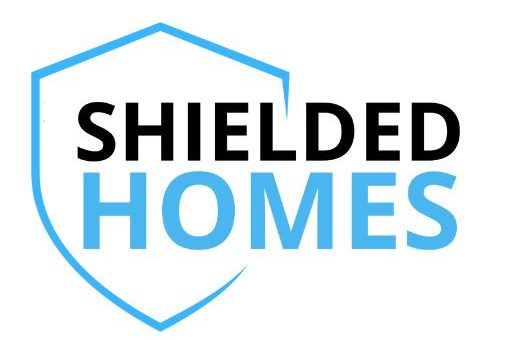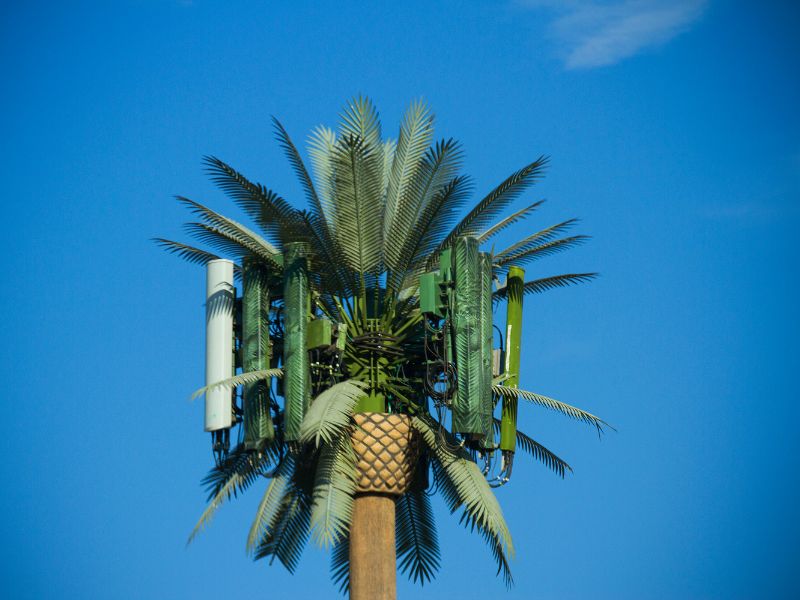
As we advance into an era where digital connectivity is a cornerstone of our daily lives, we are simultaneously stepping into a landscape densely populated with technological infrastructure. Modern cities, the epicenters of innovation and communication, have become hubs for an intricate network of cell towers. These structures are pivotal in providing the essential cellular coverage that facilitates the seamless exchange of information and the connectivity that drives our economy, social interactions, and emergency services.
However, with this surge in technological progress comes an increased exposure to electromagnetic fields (EMF). Citizens living within these urban centers are finding themselves enveloped in a constant EMF presence due to the proliferation of cell towers and antennas required to meet the insatiable demand for wireless communication services.
Looking toward the horizon, it is evident that our technological footprint will expand in tandem with advancements in connectivity. The deployment of next-generation wireless networks (such as 5G and beyond) will necessitate a denser network of cell towers to accommodate the higher frequencies and the increased data throughput required by future applications.
Detox from EMF Radiation
It is prudent to consider periodic disengagement from digital devices as a beneficial practice for one’s well-being. Nonetheless, it is important to recognize the challenge in completely avoiding electromagnetic field (EMF) radiation, as it pervades most environments. Even when personal electronic devices are deactivated, and one retreats to outdoor settings, omnipresent EMF radiation, often referred to as electrosmog, remains. This phenomenon, akin to traditional air pollution, has potential adverse health implications and is virtually inescapable in areas with cellular network coverage.
Despite the widespread nature of EMF radiation, there are designated zones known as EMF Quiet Zones where exposure is significantly reduced, if not entirely eliminated. These sanctuaries are becoming more prevalent globally as awareness increases regarding the impact of EMFs on human health. Specifically, they serve as refuges for individuals experiencing Electrosensitivity (EHS) and Multiple Chemical Sensitivity (MCS), offering an environment with minimal electromagnetic interference.
United States EMF-Free Zones
1. United States National Radio Quiet Zone – Green Bank, West Virginia
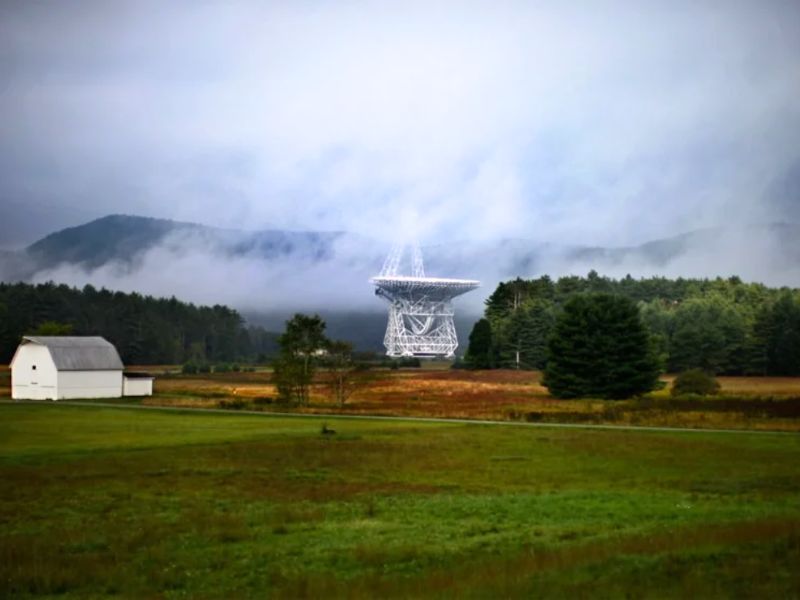
The United States National Radio Quiet Zone was established by the Federal Communications Commission to preserve the integrity of radio telescope operations conducted by the National Radio Astronomy Observatory and the United States Navy’s Information Operation Command. This 13,000-square mile domain, distinguished by its stringent limitations on electromagnetic frequency (EMF) radiation, enforces the most rigorous restrictions within a 20-mile radius of the observatory, notably around Green Bank, West Virginia. Within this perimeter, residents are precluded from utilizing devices such as mobile phones and WiFi routers.
The imposition of constraints on wireless technology in this zone is imperative due to the acute sensitivity of the radio telescopes to interference. Radio, cellular, and other electronic transmissions are confined to specific frequencies to minimize disruption. Federal mandates ensure that this region, which encompasses territories in West Virginia, Virginia, and Maryland, experiences substantially reduced cellular reception. The natural landscape, characterized by mountainous and forested terrain, further reinforces the protective barrier against signal penetration.
Green Bank is home to approximately 150 inhabitants, some of whom have consciously chosen this environment as a sanctuary from EMF radiation. Diana Schous, alongside her husband, relocated from Cedar Falls, Iowa, to Green Bank, motivated by her affliction with symptoms such as insomnia, rashes, hair loss, and headaches, which she attributes to the proximity of a cellular tower near their previous residence.
Since residing in the Quiet Zone, Mrs. Schous reports a heightened tolerance to certain electronic devices without accompanying discomfort. Nonetheless, departures from the Quiet Zone are reported to provoke her symptoms. The Schous family extends support to others experiencing electromagnetic hypersensitivity (EHS) by offering them an opportunity to assess their reaction to the unique conditions in Green Bank.
Despite the area’s designation as a Radio Quiet Zone, one resident with EHS has voiced concerns about intermittent exposure to unspecified EMF sources, which have reportedly elicited symptoms in some individuals with EHS even in the absence of conventional cellular infrastructure. This resident cautions others with EHS that residing in Green Bank may not guarantee complete avoidance of EMF exposure.
2. Smart Shelter Network – The Tabauche Refugium
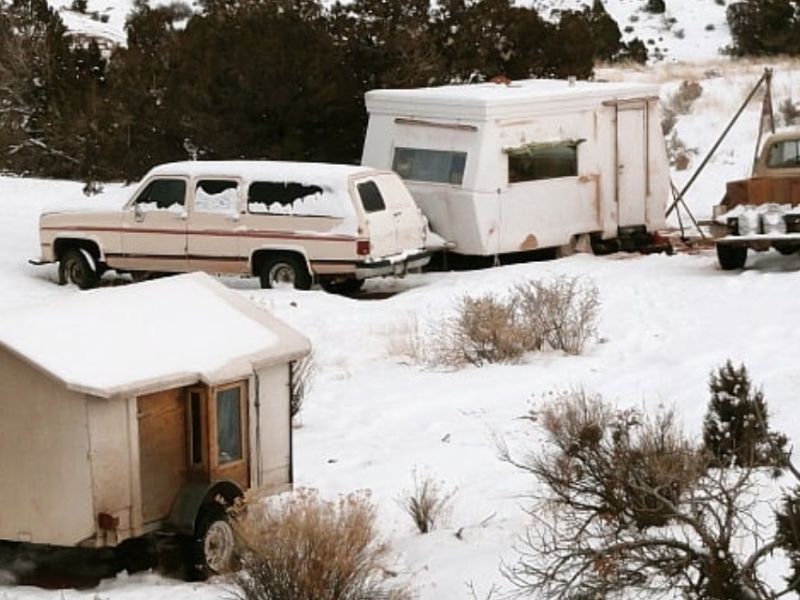
In 1996, Colorado resident Gary Duncan established the Smart Shelter Network as a response to his personal health crisis—a full onset of medical disability. Medical professionals ultimately attributed his condition to Multiple Chemical Sensitivity, a diagnosis linked to prolonged exposure to formaldehyde in building products, as well as his residence in an environment with electrical field intensities exceeding the recommended threshold of 50 volts per meter in construction standards.
In pursuit of a healthier living environment, Mr. Duncan turned to the natural world for sanctuary. His endeavor to create secure habitation options for himself and individuals with similar sensitivities led to the inception of the Smart Shelter Network in 1996, followed by the formation of the Land Steward Program.
The Land Steward Program enlists volunteers to oversee the maintenance and preservation of the Tabeguache Corridor—a vast region spanning 10,000 square miles triangulated by Telluride and Aspen in Colorado, and Moab in Utah. The program, which operates on a voluntary basis, incurs no financial burden to land proprietors or governmental bodies. Its strategic location in secluded areas is essential in providing a retreat for individuals to recuperate from the detrimental effects of electromagnetic field (EMF) radiation. Moreover, Mr. Duncan entrusts these volunteers with the dual role of fostering the land’s restoration, echoing the symbiotic relationship wherein the land aids their recuperation.
As of 2014, Mr. Duncan resided in a self-sufficient, 86-square-foot 1972 Nomad trailer, detached from conventional power grids. He maintains weekly trips to Moab to procure supplies and access expedient internet services.
3. Snowflake EHS/MCS Community – Snowflake, Arizona
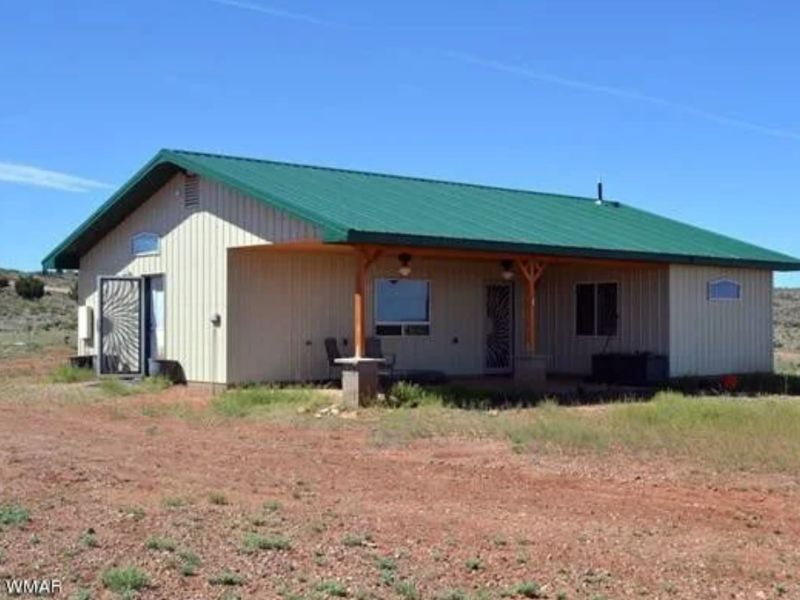
Inaugurated in 1988, the Snowflake EHS/MCS Community stands as one of the pioneering sanctuaries shielding against electromagnetic fields (EMFs). Identified as an Environmental Illness (EI) enclave, its residents, who often find themselves marginalized from mainstream society due to environmental sensitivities, have congregated to cultivate a sense of camaraderie and support for individuals grappling with similar health challenges.
Situated eight miles from the Snowflake township, the community benefits from minimal electromagnetic pollution. The remote location ensures that the nearest cellular transmission tower is a considerable five miles away, resulting in limited cellular reception.
Construction within the community adheres to stringent health-conscious principles, utilizing non-toxic materials such as pure concrete, ceramic tile, glass, steel, and aluminum. Select abodes are further enhanced with materials designed to shield inhabitants from EMFs, with the Coyote House being a representative example of such dwellings.
Kathleen Hale, a journalist from The Guardian, immersed herself in this desert community for a period of four days, endeavoring to gain a deeper understanding of the lifestyle therein. Her interactions included meeting with a resident known as Susie, who relocated to Snowflake seeking respite from the debilitating symptoms that conventional urban existence inflicted upon her. During the 1970s, Susie’s professional tenure in the Bay Area was overshadowed by a series of unexplained respiratory, gastrointestinal, and neurological ailments. Amidst the nascent stages of the AIDS epidemic in the 1980s, Susie entertained the possibility of having contracted the then-misunderstood disease. It was only after considerable self-experimentation that she identified her surrounding environment as the catalyst for her illnesses, prompting her migration to Snowflake.
Since moving to Snowflake in 1994, Susie reports substantial improvements in her health, to the extent of eschewing the use of her oxygen tank and regaining mobility. She now assumes the informal roles of a greeter, counselor, and proponent for the Snowflake populace, contributing to the welfare and integration of its members.
4. The Quiet Dome – Grass Valley, California
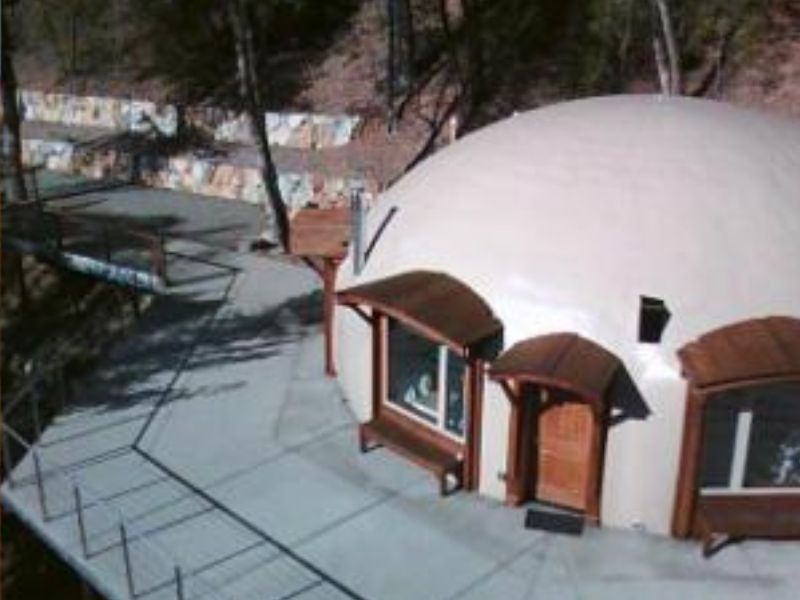
The Quiet Dome has been meticulously designed as a sanctuary amidst the Sierra Nevada Mountains to offer respite from the pervasive influence of electromagnetic pollution. Occupying a sprawling 11-acre estate, this structure is meticulously engineered to ensure an environment free from toxic materials and with minimal electromagnetic interference.
In pursuit of creating a space conducive to tranquility, the Dome is strategically located away from wireless communication infrastructure; no Wi-Fi services or cellular towers are present within a two-mile radius. It operates exclusively on uncontaminated electrical power and is equipped with noiseless domestic devices. Notably absent are “smart” appliances and compact fluorescent lights, both identified as significant domestic sources of electromagnetic fields (EMFs).
While enjoying a secluded position enveloped by forestland, the Dome’s location remains conveniently a brief 12-minute journey from the nearest urban center. Available for vacation rentals, the Quiet Dome, however, is not currently established as a facility for long-term habitation.
Nonetheless, there is a recognized benefit, albeit temporary, for those seeking relief from EMF-related ailments. A documented account on the Dome’s official website recounts the experience of Donna, a visitor who suffered from an array of distressing symptoms including headaches, heart palpitations, nausea, tinnitus, cognitive haze, sleeplessness, and irritability. Following her period of respite at the Dome, she observed a significant reduction in her symptoms by distancing herself from urban centers and areas of high electromagnetic activity, thereby not experiencing them with the same intensity as before.
5. Healthy Housing Research Institute – Rockvale, Colorado
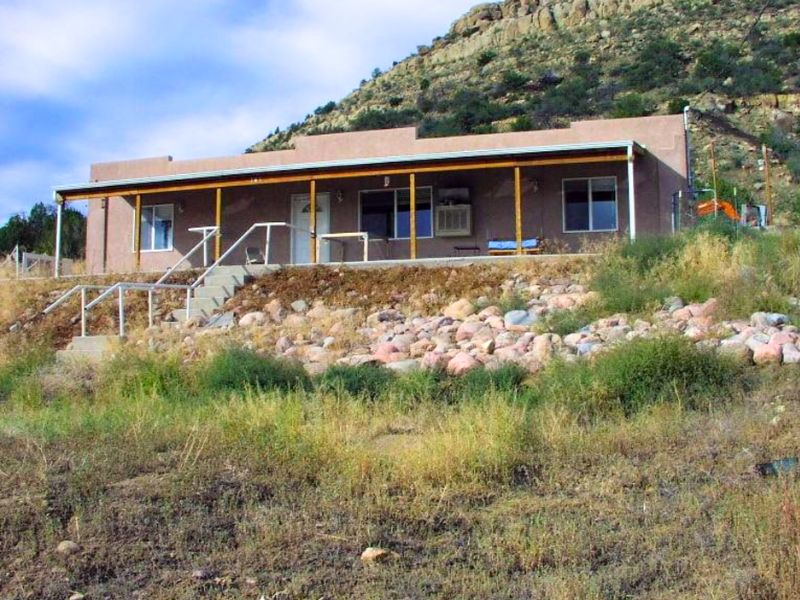
The Healthy Housing Research Institute, previously known as the ElectroMagnetic Sensitivity Research Institute, was established by Gary Johnson with the mission to innovate residential solutions for individuals afflicted with Electromagnetic Hypersensitivity (EHS) and Multiple Chemical Sensitivity (MCS).
Prior to his retirement, Mr. Johnson served as a professor of electrical engineering at Kansas State University. Adverse health reactions to wireless technology, including WiFi and cellular phones, compelled him to conclude his academic tenure prematurely and seek refuge in a less technologically saturated environment. Since 2012, Mr. Johnson has acquired a 60-acre tract of land intended for the development of abodes tailored to the needs of those sensitive to electromagnetic fields.
A segment of this land is uniquely located within a gulch, offering natural EMF radiation shielding due to its surrounding topographical features.
Mr. Johnson initiated his investigative efforts into health-oriented housing by constructing a prototype residence, essentially a dual-walled Faraday cage. This design substantially attenuates cell phone signals within its confines and features a copper-screened chamber for further EMF reduction, specifically designed for sleep. Such measures are part of a deliberate strategy to forge a habitat conducive to the wellbeing of individuals suffering from EHS or MCS.
The aforementioned prototype was successfully sold in May 2014. Through the continued construction and sale of such innovative dwellings, Mr. Johnson aims to refine the development of sustainable, health-promoting homes. His strategic plan encompasses the construction of five residential units to be offered to five separate families, followed by the creation of 24 cabins located within the protective enclave of the gulch, ultimately cultivating a therapeutic community enclave.
International EMF- Free Zones
6. EHS Refuge Zone – Drôme, France
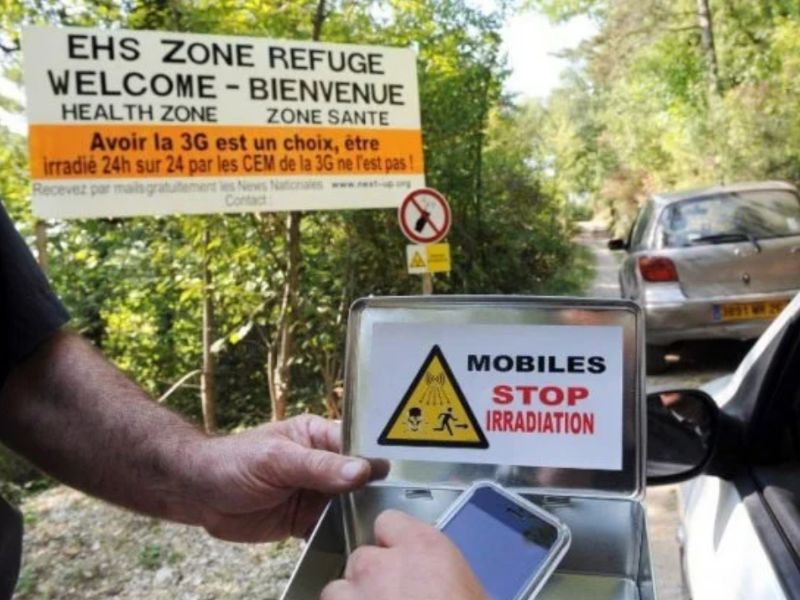
The EHS Refuge Zone represents an unprecedented initiative, situated on a pristine tract of privately-owned land in the southeastern region of France. Established by the non-governmental organization Next-Up, this sanctuary offers relief to individuals experiencing the deleterious effects of EHS. While it is not an absolute White Zone, the site benefits from significantly reduced electromagnetic radiation levels due to natural land formations and environmental features which serve to obstruct the majority of electromagnetic fields (EMFs). The ambient radiation measurements register between 0.01 to 0.02 microwatts per square meter, with slight variations contingent upon whether one resides within a van or outdoors.
The facility is equipped with communal amenities inclusive of a kitchen area, sanitation facilities comprising showers and toilets, a supply of potable water, an earthing discharge unit, and an organically cultivated vegetable garden. Additionally, a Faraday enclosure is available for use in particularly severe cases of EHS. These conveniences are offered gratuitously, with the stipulation that guests must supply an endorsed camper van or caravan for their accommodation. The Refuge Zone does have caravans available for introductory usage, albeit for a limited duration of up to three days.
7. Parc de Carnè, within the Vena del Gesso Regional Park – Brisighella, Ravenna, Italy.
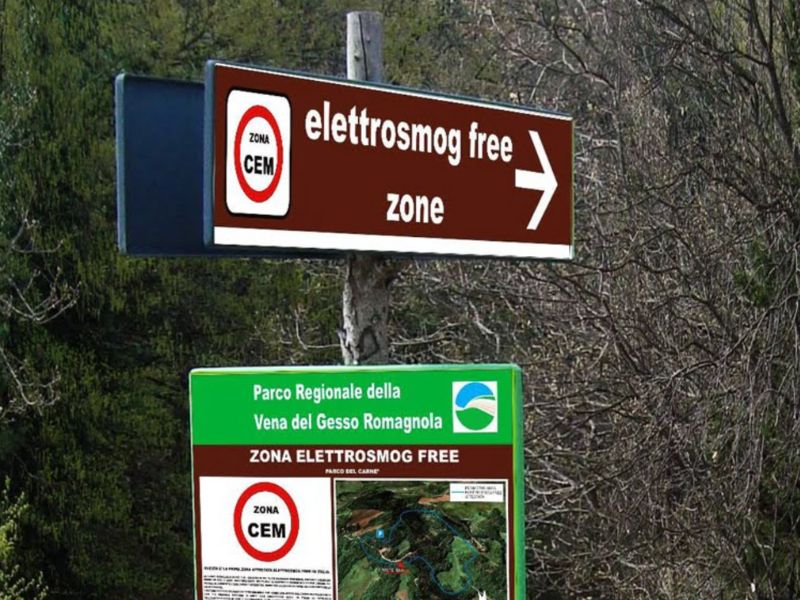
In Italy, there exists a substantial level of public cognizance and concern regarding electromagnetic fields (EMFs). Reflecting its progressive stance on EMF regulations, Italy was at the forefront in establishing a sanctuary for those with Electromagnetic Hypersensitivity (EHS).
The inauguration of Parc de Carnè in May 2010 marked Italy’s commitment to providing a refuge for EHS individuals, making it the pioneer EHS refuge zone within the nation and the second of its kind in Europe. The creation of this sanctuary was made possible through a synergistic effort between private stakeholders and the administrative support of the Emilia Romagna Park authorities.
Strategically situated between Bologna and the province of San Marino, Parc de Carnè is recognized as a White Zone where electromagnetic radiation levels are maintained well beneath the threshold recommended by independent scientific experts and guidelines set by the European Community.
The Bed and Breakfast Eremo del Lupo, which operated within this zone, was especially equipped to accommodate guests with electrosensitivity, offering rooms and facilities designed with their condition in mind. Despite its closure in the summer of 2018, the natural reserve remains open to the public, providing a serene environment for visitors to appreciate the splendor of an EMF-free natural setting.
8. Australian Radio Quiet Zone Western Australia – Murchison, Australia
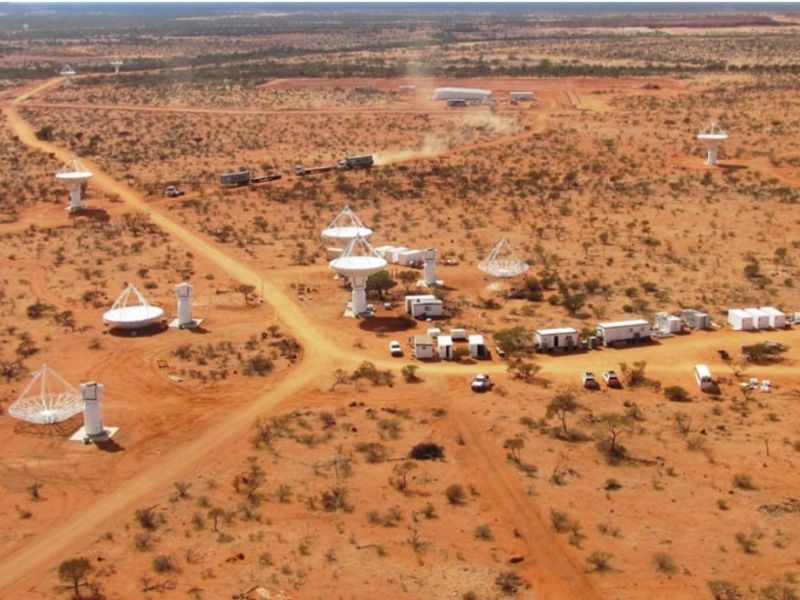
In a manner akin to the United States Quiet Zone, the establishment of the Australian Radio Quiet Zone Western Australia (ARQZWA) serves the purpose of safeguarding the vicinity of radio astronomy facilities. This protective region is segmented into three distinct areas: the inner, outer, and coordination zones. The most rigorous regulations are enforced within the inner zone, prohibiting the use of mobile phones and citizen band radios.
In the outer zone, regulatory constraints are comparatively relaxed, allowing for the government to pursue regional development initiatives while still upholding the integrity of radio astronomy research. Although not formally designated as an Electromagnetic Hypersensitivity (EHS) sanctuary, the ARQZWA inherently provides an environment with minimal electromagnetic field (EMF) radiation due to its status as a Quiet Zone.
9. Rose Hill Off-Grid Farm – Horsefly, BC, Canada
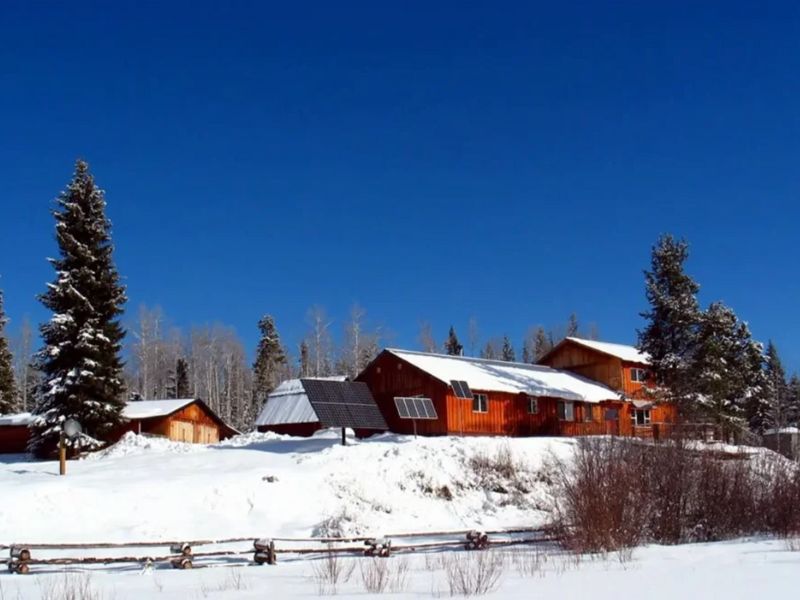
Rose Hill Farm offers a sprawling 162-acre sanctuary, operating independently from the conventional power grid, thereby ensuring an environment free from the presence of cellular towers, WiFi routers, or Smart Meters. The term ‘off-grid’ signifies a minimal reliance on electronic devices, resulting in significantly reduced electromagnetic field (EMF) radiation. Water requirements are sustainably met through well systems, while the modest electricity demands are catered to by solar energy.
For those seeking temporary accommodations, Rose Hill Farm provides a variety of short-term rental options, including cabins featured on platforms such as Airbnb. Additionally, guests have the opportunity to engage with nature through designated camping areas on the premises.
10. Zurich House, Swiss Healthy Living Foundation – Zurich, Switzerland
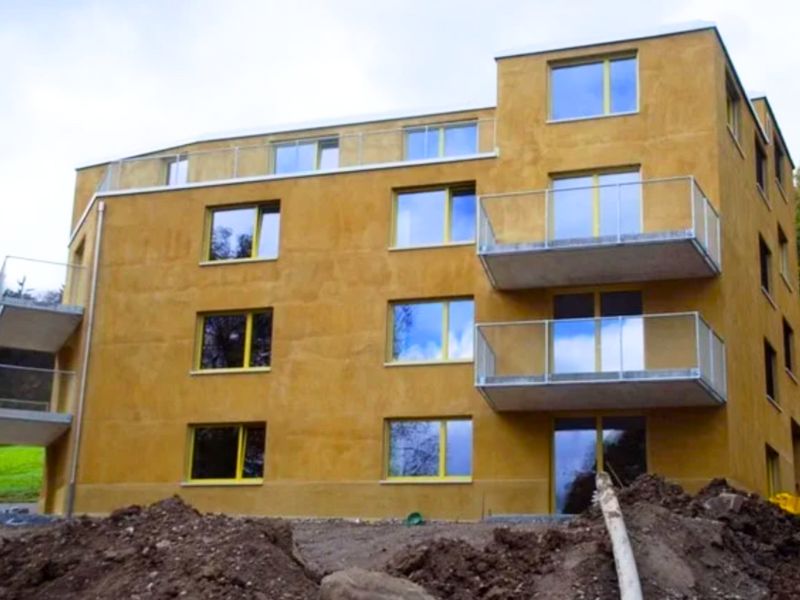
Situated on the periphery of Zurich, the Zurich House is a newly constructed apartment complex designed specifically to accommodate individuals afflicted with Electromagnetic Hypersensitivity (EHS) and Multiple Chemical Sensitivity (MCS).
This innovative venture represents the realization of a long-held aspiration of Christian Schifferle, who, for numerous years, has endured the adverse effects of MCS and EHS. These conditions necessitated his retreat into seclusion, predominantly spending his time in a caravan located near Davos in the Swiss Alps.
Schifferle, affected since childhood, expressed optimism about the project’s impact on his life, stating, “This will significantly alter the course of my life.”
In an effort to provide a solution for individuals with similar afflictions, Schifferle established the Swiss Healthy Life and Living Foundation for Multiple Chemical Sensitivity, also known by its German name Wohnbaugenossenschaft Gesundes Wohnen MCS.
Through a collaborative effort with the City of Zurich, Schifferle’s foundation received a land donation to build the apartments. The site was strategically selected for its minimal levels of radon, air pollution, noise, traffic, and electromagnetic interference. Each apartment is meticulously designed with an airlock to prevent the infiltration of external pollutants, and utility closets are strategically located within these airlocks to maximize the distance from the living areas. Additionally, the apartment layouts are crafted to minimize electromagnetic frequency (EMF) exposure to neighboring units.
The construction of the building incorporates the use of shielded electrical wiring and walls built with concrete and hollow bricks that provide radiation insulation. As a result, mobile phones and other wireless devices are non-operational within the apartment units.
Since its inauguration in the summer of 2014, the Zurich House has reached full occupancy and stands as a testament to the project’s success and the fulfillment of a visionary dream.
Finding other EMF Quiet Zones
Numerous less prominent regions with minimal electromagnetic field (EMF) radiation exposure exist that are not enumerated in the preceding text. These locales, typically referred to as Radio-Quiet Zones or White Zones, are depicted on maps as areas lacking cellular service coverage.
Geographically challenging areas, such as those with rugged mountains and dense forests, naturally obstruct EMF signals, which under normal conditions could propagate for tens of miles. It is generally understood that isolation enhances the reduction of EMF exposure. Various online communities, specifically Facebook groups for individuals with Electromagnetic Hypersensitivity (EHS) or Multiple Chemical Sensitivity (MCS), share resources ranging from specialized Airbnbs to secluded farms that offer respite from EMF and other environmental contaminants.
As a general guideline, maintaining a distance of at least a quarter-mile from cellular towers is recommended to mitigate potential adverse effects. Nevertheless, given that some towers have the capability to transmit signals over greater distances, individuals with heightened sensitivity may still experience discomfort.
Many places with radio telescopes, like the one in Green Bank, need EMF to be absent in order to detect radio signals from remote stars and galaxies. They can be disturbed by even the slightest signals, so usually observatories are placed in very remote, protected areas. The Scientific Committee on Frequency Allocations for Radio Astronomy and Space Science (IUCAF) has published a map of radio telescopes around the world. However, not all radio observatories need protection since they might use frequency bands that aren’t disturbed by telecommunications. Some that have Radio-Quiet Zones are listed below:
- Arecibo Observatory, Puerto Rico
- Astronomy Geographic Advantage Act (AGAA), South Africa
- Atacama Large Millimeter Array (ALMA), Chile
- Dominion Radio Astrophysical Observatory (DRAO), Canada
- Five hundred meter Aperture Spherical Telescope (FAST), China
- Institute for Radio Astronomy in the Millimeter Range (IRAM), Spain
- Itapetinga Radio Observatory (IRO), Brazil
- Large Millimeter Telescope (LMT), Mexico
- Pushchino Radio Astronomy Observatory, Russia
Presently, locating an area devoid of electromagnetic fields (EMF) may pose a challenge, typically restricted to isolated islands or undeveloped mountainous or desert regions. However, the prospect of finding such EMF-free zones is expected to diminish in the coming years. This anticipated change can be attributed to the deployment of an expansive network of low-orbit 5G wireless satellites. Unlike conventional cellular towers or terrestrial fiber-optic infrastructure, these satellites will extend coverage to previously inaccessible locations, effectively reducing the remoteness of these areas. Nonetheless, the precise impact of these satellites on the surrounding EMF levels remains uncertain.
Furthermore, the implications of this satellite network on critical scientific and meteorological operations, including astronomical observatories and Doppler weather radar systems that operate on similar millimeter wave frequencies, have yet to be determined.
As we navigate these technological advancements and their potential implications, it may be worthwhile to consider an EMF detox in a White Zone—a location largely untouched by electromagnetic interference—as an unconventional yet potentially beneficial health intervention.
